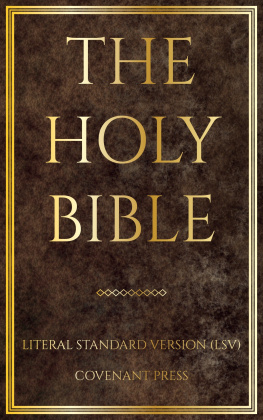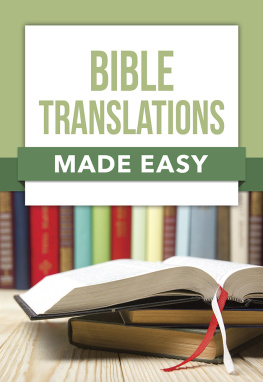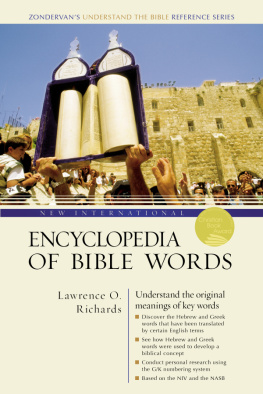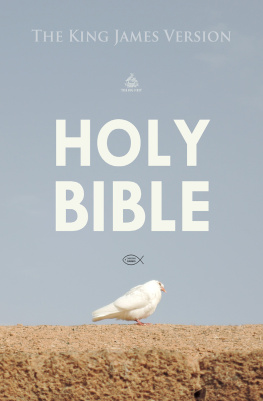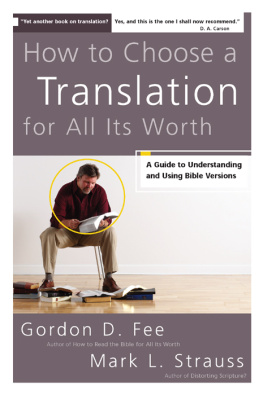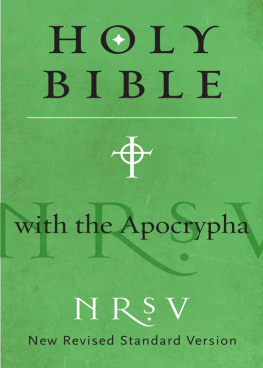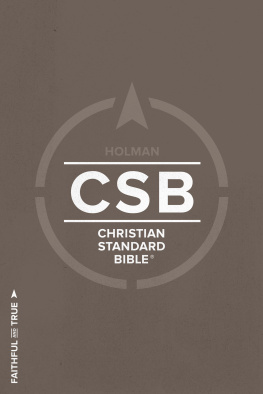THE HOLY BIBLE
Literal Standard Version (LSV)
www.lsvbible.com
By Covenant Press
Literal Standard Version of the Holy Bible
Copyright 2020 by Covenant Press and the Covenant Christian Coalition
PREFACE
Many have undertaken translation of the sacred Hebrew, Aramaic, and Greek writingsknown collectively as The Holy Bibleinto English, with varying degrees of success. The word Bible comes from the Greek , the plural form of (book or scroll). Thus, the Holy Books or Holy Scrolls are the protocanonical collection of God-breathed writings central to Judeo-Christian belief. Christians regard the original autographic manuscripts to be directly inspired by God, inerrant (without error), and infallible (without fault; i.e., incapable of fallacy). The absolute truth of God revealed therein is the basis for the Protestant/Evangelical doctrine of Sola Scriptura (by Scripture alone)the fundamental belief that Gods word stands alone as the ultimate arbiter of religious, spiritual, and historical truth because that knowledge which is directly revealed by God to mankind is perfect and without flaw. All beliefs and theories regarding origins and religion are only true insofar as they agree with Scripture, and are false inasmuch as they disagree.
While Christians recognize the infallibility of the autographs, there is also necessary recognition that the original writings have been lost to history. What we now possess are manuscript copies or copies of copies of the originals. Some of these copies were made shortly after the originals and others were written many decades later. To complicate matters, there are distinct manuscript versions and text-types of the Old and New Testaments with minor discrepancies. For the Old Testament we must consider the distinctives between various manuscript versions such as the Masoretic Text (MT), Septuagint (LXX), Samaritan Pentateuch (SP), and Dead Sea Scrolls (DSS). And for the New Testament, translators compare the Alexandrian, Western, and Byzantine text-types.
The goal of any good translation is to produce a readable text that preserves the original autographic meaning and comes as close as possible to translating, word-for-word, manuscripts that accurately represent the original writings. Its with this goal in mind that the Literal Standard Version (LSV) was writtena modern, yet literal English translation based upon the most prolific texts: the Masoretic Text (MT) for the Old Testament and the Textus Receptus (TR) and Majority Text (M) for the New. However, in certain, specific instances other manuscript versions and text-types are used where the evidence seems incontrovertible (e.g., the LXX and DSS in the Hebrew and Aramaic; the Alexandrian in the Greek).
While many may at first feel disoriented by the cacophony of textual questions, it should be stated with utmost certainty that one of the many things that sets The Holy Bible apart as the unique and divinely inspired word of God is that the manuscript evidence for it is simply overwhelming. No other ancient text, religious or otherwise, has as much manuscript support as The Holy Bible. There are literally tens of thousands of papyri fragments, external citations, and complete copies of ancient manuscripts in the original languages and though there are minor variations, the texts, across all versions, are largely identical. Recent discoveries, such as the Dead Sea Scrolls, add further weight to the authenticity of the Scriptures and the accuracy of the translation-base from which we translate to English.
Distinctive features of the Literal Standard Version of The Holy Bible:
- A modern, literal, word-for-word (formal equivalence) English translation of the Holy Scriptures utilizing English word rearrangement when necessitated for readability. The LSV is the most literal translation of The Holy Bible, with significant improvement over previous literal translations, including Robert Youngs excellent Youngs Literal Translation.
- Preservation of verb tenses wherever possible.
- Utilization of the transliterated Tetragrammaton in the Old Testament. All uppercase Lord is used in the New Testament when a reference to Yhwh is likely.
- Generally consistent approach to formal equivalence translation; most English translations use a broad set of words when translating a single Greek or Hebrew word based on context. We are striving to only use varying words when the context demands it.
- Removal of many Hebrew and Greek transliterations; remember, transliterations are generally not translations.
- Unlike most translations, justified typographic alignment consistent with the style of the original Hebrew, Aramaic, and Greek biblical autographs. The ancient caesura mark is used for easy readability of poetic literature such as the Psalms.
- Inclusion of the verses found in older English translations such as the King James Version (KJV) that are not found in many modern translations; and inclusion of the alternative LXX Genesis chronology set next to the MT. These are contained within bolded double brackets for distinction.
- Capitalized pronouns and other nounal forms when referring to God, Christ, or the Holy Spirit. References to the Messenger of the Lord are also capitalized when the subject appears to be a clear reference to God or the Messiah (as found in translations such as the NKJV).
Why should we trust in The Holy Bible over other religious, historical, and scientific texts?
The Holy Bible is the complete account of Gods revelation to mankind, telling the whole story of history from beginning to end. We can know with absolute certainty that the Bible is true because the Bible is God-breathed. In its original Hebrew, Aramaic, and Greek manuscripts it is inerrant and infallible. The true God spoke true words to fallible human beings (cf. 2 Tim. 3:1617 and 2 Pet. 1:2021). Enabled by the Holy Spirit, they were moved to accurately record Gods message. But, understandably, that answer will not satisfy the skeptic. There are at least six key arguments that powerfully vouch for the Bibles unique authenticity:
Every claim in the Bible that can be demonstrably tested has been verified. In other words, if we presently possess some scientific know-how, archaeological discovery, or corroborating text that can directly test a specific claim from the Bible, the claim has been verified. As a matter of fact, this truth has been a great source of humiliation for secular historians over the past several decades as discovery after discovery has proven the Bible true even after historians had said it just cant be. Whether it be the fallen walls of Jericho, the reign of King Hezekiah, or even the existence of a Jewish temple, every bit of physical evidence that has turned up to answer the Bibles claims has proven the Bible true.
There are more ancient manuscripts of the Bible than any other ancient text. Furthermore, the discovery of the Dead Sea Scrolls in 1946/47 dealt a significant defeat to the theory of that generations textual critics. They taught that the Old Testament was composed much later than Jews and Christians believed and had undergone a significant evolution in content. Not only did the Dead Sea Scrolls disprove that claim, showing that the Old Testament we have today is equivalent to the one used by Christ and His disciples, but they also provided rock-solid evidence that numerous prophecies about Jesus Christ were written before He was born.
The Bible contains self-verifying mathematical and thematic codes underlying the text. In recent years scholars have discovered numerous number patterns in the text in various books such as Genesis and the synoptic gospels, that would be impossible for humans to have developed on their own. There are similar thematic codes that testify to the Bibles divine origins.
Next page
